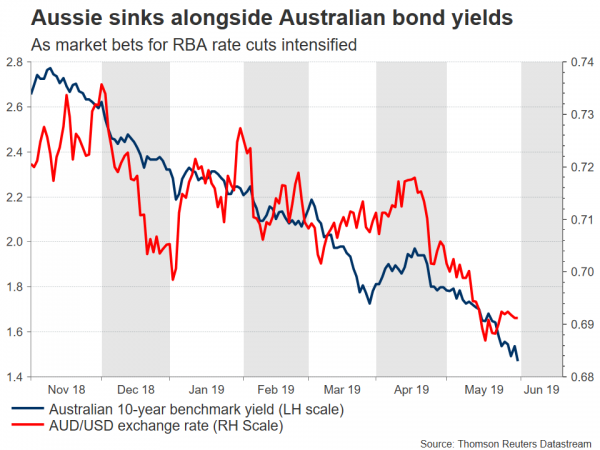The Reserve Bank of Australia (RBA) is widely expected to cut rates when it announces its policy decision on Tuesday at 04:30 GMT. With a cut fully priced in already, and another one by September, price action in the aussie will likely depend mainly on how aggressive the signals for future easing are. While the Bank may disappoint the bears at this meeting, the broader outlook for the currency remains negative.
Markets are all but certain the RBA will embark on an easing cycle starting next week, in an attempt to fight off a rising unemployment rate, as well as tepid growth and inflation. Indeed, Governor Lowe recently confirmed a rate cut will be ‘considered’ at the June meeting, which was seen as a clear signal that one will take place, given both a worsening domestic outlook and simmering trade conflicts globally.
What is much less certain though, is the scope and breadth of this easing cycle – in other words, how low interest rates will go. In that sense, market pricing currently implies another quarter-point cut by September after this one, and then another 30% probability for a third one by December. Remember, these expectations are already reflected in the exchange rate, so for the aussie to weaken further on the decision, the RBA would likely need to signal it plans to cut rates even more aggressively than this.
While the central bank is almost certain to cut and leave the door wide open for more, it’s questionable whether it will go as far as provide the ultra-dovish signals the market is looking for. Policymakers typically prefer to retain some optionality and not pre-commit to anything far in the future. More importantly, the recent election result implies more expansionary fiscal policy than previously anticipated, which will take the ‘heavy lifting’ off the RBA’s shoulders. Similarly, the nation’s prudential regulator just announced plans to loosen lending rules, which may fuel borrowing.
All the above don’t go to say that the RBA won’t ultimately slash rates deeper than what’s currently priced. Rather, that the Bank is unlikely to feel the urgency to signal such extraordinary easing so early, which may disappoint the bears given the already-dovish pricing. Therefore, it wouldn’t be a surprise to even see the aussie spike higher on the decision, if officials indicate that further easing will depend on the data for example.
In the bigger picture, however, the outlook for the currency is still negative, not least due to the possibility of a further escalation in trade tensions, and the effect that may have on Australia both directly via dwindling export volumes and indirectly through softer commodity prices. Hence, even in case of a rebound, any positive reaction may remain fairly short-lived.
Technically, a potential spike up in aussie/dollar could stall at 0.6940, with an upside break opening the door for 0.7050. On the downside, declines may find support near 0.6860, where a bearish violation would turn the focus to 0.6740.
Finally, note that the nation’s retail sales for April will be released a few hours ahead of the rate decision, while GDP data for Q1 are due the next day.
